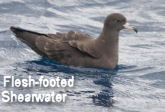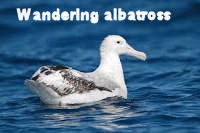The Status of U.S. Oil Production
 Why has the U.S. mainstream media stopped cheerleading the fracking boom? Looks like production is no longer booming.
Why has the U.S. mainstream media stopped cheerleading the fracking boom? Looks like production is no longer booming.
 Why has the U.S. mainstream media stopped cheerleading the fracking boom? Looks like production is no longer booming.
Why has the U.S. mainstream media stopped cheerleading the fracking boom? Looks like production is no longer booming.
 Thirteen species of seabirds are declining off the coast of south-eastern Australia, a 17-year study by researchers at the Centre for Ecosystem Science at UNSW Sydney revealed. The species include iconic and globally threatened birds such as the enormous Wandering Albatross, as well as locally breeding Flesh-footed Shearwater. Pelagic citizen science data was used in this study.
Thirteen species of seabirds are declining off the coast of south-eastern Australia, a 17-year study by researchers at the Centre for Ecosystem Science at UNSW Sydney revealed. The species include iconic and globally threatened birds such as the enormous Wandering Albatross, as well as locally breeding Flesh-footed Shearwater. Pelagic citizen science data was used in this study.
Working with data collected by seabird enthusiasts of the Southern Ocean Seabird Study Association, who regularly take boat trips out to sea from Port Stephens, Sydney and Wollongong, the scientists found that almost half of the 30 most commonly observed seabird species in the region had declined over the 17-year period from 2000 to 2016. The study is published in the latest issue of the international scientific journal, Biological Conservation.

“Seabirds are critically important organisms for maintaining the health of marine ecosystems,” says lead author and UNSW Science Honours student Simon Gorta.
“They act as apex predators, feeding on a range of prey such as plankton, squid, fish and carcasses across the world’s oceans.
“Our findings are worrying, not just because thirteen of our more common species are declining, but because we don’t know for sure what is driving these declines.”
While the exact mechanisms are unknown, the researchers suggest that warming ocean temperatures are likely to be contributing to this trend. The East Australian Current has strengthened off south-eastern Australia, which has led to warmer and less productive waters in the region, potentially driving birds to forage elsewhere, as the marine habitat in this region is no longer suitable for them.

“We can predict that as surface temperatures increase with climate change, we will be seeing fewer species that prefer cooler-than-average surface temperatures. The most dramatic example of this was in summer species – Pomarine and Arctic Jaegers - which showed this surface temperature preference and consistently declined in the region over the 17-year study period,” Mr Gorta says.
Worryingly, many other species may also be declining. This is supported by declines in breeding populations of seabirds, linked to a number of threats globally. The researchers say that determining the exact causes of these declines should be a priority.
“Seabirds are the most threatened group of birds on the planet, with roughly 30% of them listed on the IUCN Red List as at risk of extinction,” says co-author Professor Richard Kingsford, Director of the Centre for Ecosystem Science.
“They are threatened where they forage at sea, and where they breed, from commercial fishing and pollution at sea, as well as habitat degradation and introduced predators such as rats at breeding sites.”
Relatively little is known about seabirds away from their breeding grounds, as most research efforts are focused on protecting the species at these sites. The researchers identified a clever solution to this by analysing a citizen science dataset, collected by passionate birdwatchers who go on birdwatching trips or “pelagics” out to sea, looking for seabirds almost every month of the year.
“These types of at-sea observations of seabirds are difficult to come by, so we relied on a unique dataset, collated from birdwatchers’ observations. These datasets are just sitting around from all over the world – waiting to be fully dusted off and used to investigate broader patterns which go well beyond usual three-year funding cycles,” says senior author Corey Callaghan, PhD student at UNSW.
These pelagic seabirds occur in coastal and shelf waters off the coast of every continent except Antarctica, and observations from these trips offer a different, and important insight into the behaviour of seabirds, only otherwise attainable by using expensive tracking equipment on a few individuals.
“These observations inform real and informative trends of great importance to marine ecosystem management and conservation, and they do so through the engagement of the general public. It is important that everyone, not just the researchers, know what is going on in our oceans, because we depend on them, yet they are degrading before our eyes,” says Mr Gorta.
“These issues must be addressed in order to halt the long-term declines of seabirds.”
Recent comments